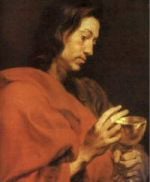A Doctor's Hands
The people listening to Jesus' story would have been in a state of shock. They had heard about the priest, then the Levite, ignoring the victim-almost certainly Jewish - of the bashing. So, they would have expected that next, a layman would intervene. Instead it is a traditional enemy a Samaritan, who steps up to help. He is the one who is a neighbour to the man who was robbed. So, for the Good Samaritan, everyone is a neighbour, no one is excluded. His compassionate hands express his compassionate heart. He goes way beyond the call of duty, and shows us the difference between someone who only does a job, and the true professionals who give not just their time, but themselves.
The parable of the Good Samaritan is one of Our Lord's best known teaching stories. While his life, death and resurrection teach us many things, it is interesting to note the number of stories which continue to carry and spread his influence around the globe and across 2000 years.
I cannot resist digressing with two comments on this parable.
Most of you would be too young to remember Margaret Thatcher, Prime Minister of Great Britain in the 1980s, a remarkable woman, a free marketeer who changed British society. She pointed out that if the Good Samaritan had not been a successful businessman, possessing the necessary capital, he could not have helped the victim. This is true.
My other memory is of a guide in the Holy Land pointing out the inn where the Good Samaritan lodged the injured traveller outside Jericho! It did not seem worth the effort to explain that Our Lord was not recounting an actual incident. It is a small example of how traditions can be changed and embellished as they are handed down.
I think what Blessed John Paul II said to artists, on his visit to La Scala Opera House in 1983, can easily be applied to you as trainee doctors. The Pope was speaking about the special gifts of artists, but it equally fits your being neighbours to every patient who comes to you for help:
Be always ready to welcome this higher light, which, being a gift that is added to your personal talents, cannot be a closed and selfish possession. Rather it is to be shared and offered . . . to all those who are expecting help. ... Just like the bodily works of mercy which are the duty of everyone, finding expression in institutions, hospitals, associations so from you, artists and intellectuals, I ask here . . . to fully develop in the light of a faith which is not only human, but also and especially Christian, the spiritual works of mercy, which perhaps today, in the context of a consumerist society, are even more necessary than the first kind. Today there is doubt, there is sadness, there is, unfortunately a rather widespread and massive moral crisis. Today there is a need to comfort, to illuminate, to help.
Because good medicine is not only a bodily work of mercy, but, like a beautiful work of art, it is a spiritual work of mercy too. Like old doctor Oreshchenkov in Solzhenitsyn's novel, Cancer Ward, your medical practice is not only drawing on the most advanced techniques of medical practice. Looking back on himself and everyone he has ever known, he did not see the meaning of existence:
As embodied in the work or activity which had occupied these people, which they believed was central to their lives, and by which they were known to others. The meaning of existence was to preserve untarnished, undisturbed and undistorted the image of eternity which each person is born with-as far as possible.
Like a silver moon in calm, still lake.
It is that inner transparency of your spirit that will lift your hands almost to the level of carrying out a sacramental act. Your medical professionalism expresses your heart's response to your patient as one who reflects the face of Christ even more than a transparent lake reflects the silvery light of the moon. Then, what can be said of the artist's instruments can equally be said of your hands. They are at the service of each neighbour seen as a living tabernacle of the presence of God. So we can say that:
A pen does not know what it is going to write.
An artist's brush does not know what it is going to paint.
In the same way, when God takes someone into His hands
in order to begin some work for God in her or his
neighbour,
that person does not know what he or she will have to do.
He or she is an instrument.
And generally all God's instruments are characterized
by this quality: littleness, weakness...
"...so that no human being might boast
in the presence of God."
And while the instrument moves in the hands of God,
He shapes it with thousands and thousands of painful
and joyful actions.
In this way He makes it more and more suited
to the task it must carry out,
and it can say with complete truth: I am nothing,
God is everything.
And that is my prayer for each one of you young doctors-in-training here today.
In the name of the Father, and of the Son, and of the Holy Spirit. Amen.
This item 9884 digitally provided courtesy of CatholicCulture.org






